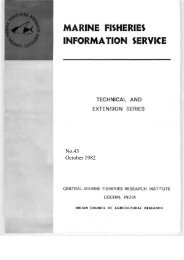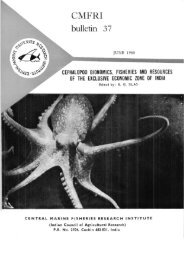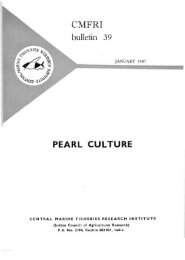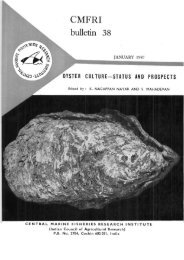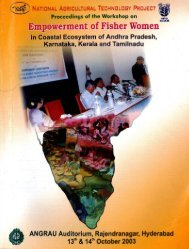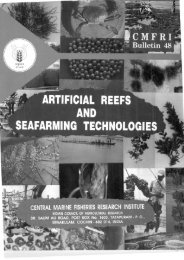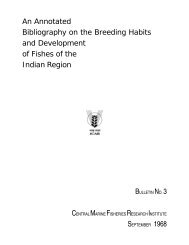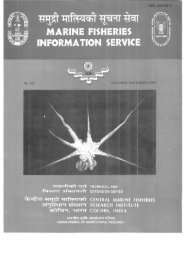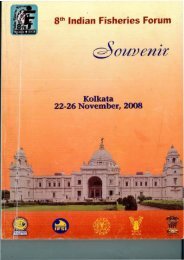Marine Fisheries Information Service - Eprints@CMFRI - Central ...
Marine Fisheries Information Service - Eprints@CMFRI - Central ...
Marine Fisheries Information Service - Eprints@CMFRI - Central ...
You also want an ePaper? Increase the reach of your titles
YUMPU automatically turns print PDFs into web optimized ePapers that Google loves.
<strong>Marine</strong> <strong>Fisheries</strong> of Andhra Pradesh-An Appraisal 13<br />
Table 8. Growth and stock parameters of commercially important species off Andhra coast<br />
Species L∝ (cm) K (annual) Z M F E<br />
S.gibbosa 19.1 1.5 5.41 1.5 3.91 0.7<br />
R.kanagurta 27.9 1.7 13.8 1.38 11.7 0.9<br />
T.lepturus 115.0 0.2 1.8 0.4 1.4 0.8<br />
S.guttatus 67.7 1.2 2.44 1.63 0.81 0.33<br />
T.albacares 240<br />
N.japonicus 34.0 0.53 2.78 0.48 2.30 0.83<br />
S.undosqaumis 39.4 0.33 2.19 0.42 1.78 0.81<br />
U.vittatus 25.1 0.67 7.05 0.75 6.30 0.89<br />
J.carutta 29.7 0.32 2.09 0.44 1.65 0.79<br />
O.ruber 45.0 0.20 0.90 0.29 0.61 0.68<br />
M.monoceros Male 18.9 1.35 6.7 1.28 5.42 0.81<br />
Female 22.9 1.43 5.6 1.26 4.34 0.78<br />
M.dobsoni Male 11.8 0.71 4.92 0.96 3.97 0.74<br />
Female 12.1 0.81 3.91 1.03 2.88 0.81<br />
P.sanguinolentus 17.1 1.1<br />
Male 17.2 1.1<br />
Female<br />
economics of operation (increase in operational costs<br />
and fall in earnings) is in a way forcing some of the<br />
boat owners to reduce the number of operating days<br />
or altogether abstain from fishing. Reducing the<br />
fishing pressure in the presently fished zone is of<br />
crucial importance. The optimum fleet strength in<br />
relation to the fishable stocks as determined by<br />
various studies have to be taken into account and<br />
steps have to be taken to limit the number of boats.<br />
The presence of several resources especially the<br />
oceanic yellowfin tuna off Visakhapatnam along<br />
Andhra coast presents an ideal situation for<br />
diversification of fishing activities. In order to harvest<br />
the presently underfished yellowfin stocks as well as<br />
to reduce the fishing pressure, it is suggested to<br />
modify suitably and deploy some of these crafts in<br />
the deeper waters. Targeted fishing for yellowfin tunas<br />
by the local fisherfolk is a recent trend. It is still<br />
dominated by the traditional fisheries sector. There<br />
is therefore a need to adopt focused operational<br />
strategies to optimally harvest these oceanic<br />
resources. A number of indigenous crafts from<br />
Pudimadaka and Lawsons Bay villages are operating<br />
in the oceanic waters to harvest the yellowfin tunas.<br />
The crafts used are traditional wooden catamarans<br />
(Plate 5) fitted with huge sails. The prohibitive cost of<br />
wood and recurring expenses incurred to maintain<br />
them has in a way induced the local fishermen to opt<br />
for the more durable and less expensive fibre crafts.<br />
The sail driven crafts are able to reach the fishing<br />
grounds (>200 m depth) in about three hours when<br />
the wind conditions are good. Fishing is carried out<br />
using long lines as well as trolls for about 2-3 hours<br />
after which the crafts return to the shore. Normally,<br />
when good weather conditions prevail a single fishing<br />
day takes 8-9 hours. However, when poor wind<br />
conditions prevail, the catamaran takes much longer<br />
to reach the fishing ground and return after the fishing.<br />
Fishing by these catamarans is totally stopped if wind<br />
conditions are not suitable and also when the sea is<br />
Plate 5. Traditional wooden tepalu used for hunting the<br />
oceanic yellowfin tunas occuring off Andhra coast




